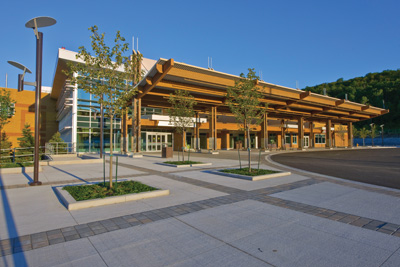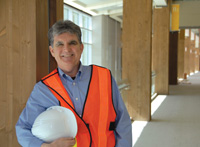
Healing Power
October 18, 2010
By Bill Tice
As Brian Bertrand walks through the almost completed North Bay Regional Health Centre in North Bay, Ontario, he is obviously very proud of what he and his team have accomplished.
As Brian Bertrand walks through the almost completed North Bay Regional Health Centre in North Bay, Ontario, he is obviously very proud of what he and his team have accomplished. As lead architect for the $350-million hospital project, he enthusiastically points out the building’s distinctive features, from windows that were designed to take advantage of natural light throughout the day, to finishing touches that reflect the distinctive four seasons of the northern Ontario surroundings.

|
|
| The North Bay Regional Health Centre was designed with the potential to consume wood for some of its heat and power. Photo: Evans Bertrand Hill Wheeler Architecture |
Bertrand, who is a partner at Evans Bertrand Hill Wheeler Architecture Inc. in North Bay, is equally animated when talking about the hospital’s options for power and heat, noting that biomass may play a significant role in this area down the road. He explains that one of the key mandates for the architectural team was to capture green efficiencies within the building’s design. “The hospital was never designed to run solely on a cogeneration system or biomass, but these methods could certainly supply a substantial amount of power during peak loading times,” Bertrand explains. “This was all considered to be leading edge back in 1997 when we started on this project. The client was quite visionary, and when we were looking for a methodology for capturing green efficiencies, we adopted LEED (Leadership in Energy and Environmental Design) as the methodology of choice, recognizing that LEED wasn’t even in Canada at that time.”
Cogen for Today
Right now, a cogeneration power station is what is in the works for the hospital, which reached “substantial completion” in June 2010 and is scheduled to open its doors officially at the end of January 2011. The hospital is a “P3” project (public-private partnership), says Bertrand, adding that when it was first started, they investigated biomass as an option, but at that time it was “really in its infancy” and pelletization didn’t exist. “Slash from the forest industry would have been the fuel source, and that fuel source was not compatible in terms of an on-site fuel storage area. We investigated it as a viable option, but physically, the technology available at the time didn’t allow it to happen.”
 |
|
| Lead architect Brian Bertrand has received invitations to speak about the health centre’s distinctive design features at several international conferences. |
Then, in 2007, when a consortium led by Plenary Health, a subsidiary of Vancouver’s Plenary Group Canada, was awarded the contract for a design, build, finance, and maintain model for the hospital, the idea of biomass was once again introduced as part of the Plenary Group’s bid. “We planned ahead and we have created the ability to tap into fuel sources such as biomass, whether on site or off site, and to be able to hook up with our mechanical system. So we have provisions in place to use biomass or a cogeneration plant,” adds Bertrand. “We really have a great deal of flexibility.”
That’s good news for the Nipissing First Nation, which is in the early stages of building a wood pellet plant that will be located well within the geographic range of cost effectively delivering pellets to the hospital (see sidebar below). Although Dwayne Nashkawa, the Nipissing’s executive director, says they had hoped to have the pellet plant up and running by August 2010, the project is in limbo right now due to some land title issues, which is hampering financing efforts. “We are confident that we will be able to work through these issues and we fully expect to break ground on the plant in the spring of 2011,” he explains from the Nipissing’s office near the shore of Lake Nipissing in Garden Village, Ontario.
Biomass Advantages
Back at the North Bay Regional Health Centre, Bertrand says that at this point, Johnson Controls International, which is one of the main companies forming the consortium (the others are PCL construction and Deutsche Bank), is in the process of securing bids for the cogeneration equipment, but he doesn’t rule out biomass in pellet form in the near future. “The advantage of using biomass is that it can be a cost-effective method of securing locally available fuel,” he says. “The hospital will be the first LEED certified project of its kind in eastern Canada. Consequently, we see biomass as tying in nicely with the hospital’s strategy, and it’s sustainable. It supports the local economy and it helps to develop a market-based sector that is geared towards northern Ontario.”
Bertrand says that using pellets would address one of the earlier concerns of using biomass to power and heat the facility. “Slash storage was our biggest problem,” he explains. “This will be the first time in Canada that a forensic mental health facility will be co-located with an acute care hospital, and one of the key drivers for us was the need to create a healing environment. It has been documented that having a strong connection to nature is important for this environment, and that includes having landscaped grounds and walking trails through the forest. Large trucks delivering slash on a frequent basis and piles of slash on site are not conducive to this environment.”
Bertrand has become recognized as somewhat of an expert in incorporating biomass into architectural design. “I have been very blessed,” he says. “I was invited to speak at the World Health Organization in 2002, I have spoken to audiences at the Centre of Health Care Design and the Canadian Wood Council, and I have been asked to speak this year in Chicago at the Healthcare Facilities Symposium and Expo. There are many firsts for the North Bay Regional Health Centre, and it is gaining a lot of attention.”
His advice for anyone contemplating the inclusion of biomass in a building design project: “There are key milestones in any architectural design process, and major decisions are made early on, so if you are planning to incorporate a biomass component, have the knowledge and information very early so that you can weave it and integrate it into your project. You can’t go back and retool later on. How we got around it with the hospital is we created an extremely flexible system so that we can adapt as technologies change in the future.”
| Local Interest in Biomass Biomass as an option for power and heat is already present in North Bay in a big way, says Pauline Rochefort, executive director for the Office of External Relations and Advancement at Nipissing University and a former project manager with the university’s Biomass Innovation Centre. “At a conference we held last fall, we had participation by a few other hospitals in northeastern Ontario,” she explains. “These are hospitals that currently run on oil and diesel and they are interested in finding alternative energy sources.” The conference was expected to attract about 60 participants, but ended up with more than 400. “There has been a heightened interest in biomass from many local communities. This area has a long history with biomass and has experienced high traffic in terms of international trade delegations coming here to look at biomass options.” Nipissing University is highly regarded for its work in biomass, and in 2009, its School of Business and Economics established the Nipissing Biomass Innovation Centre. It received $71,500 from Ontario’s Community Go Green Fund. The centre’s objective is to teach people about biomass heating systems, with the ultimate goal of reducing greenhouse gases and eliminating the use of more than half a million litres of oil annually. Locally, Nipissing Elementary School is considering a switch to biomass. The school currently runs on propane, and Rochefort says it would be an ideal project to showcase what can be done by converting to biomass, especially with the Nipissing First Nation close to breaking ground on a new wood pellet plant that would rely on biomass for its raw material. As for the North Bay Regional Health Centre, Rochefort says it is an “attractive opportunity” for everyone involved. “This building is built with lots of wood, can be powered by wood, and the design is influenced by the First Nations in this area and the environment. It is a green building that takes a major step forward in terms of sustainability.” Sustainable Pellet Plant for Nipissing First Nation Nashkawa says that they originally planned on breaking ground on the pellet plant in the summer of 2010 and wanted to be up and running by fall, which would have made it operational by the time the North Bay hospital project was completed. However, he says that the project has been delayed because of an issue related to land tenure. “It’s very complicated, but in a nutshell, the site is located on land that is in the process of being returned through a land claim settlement, and the title to the land is uncertain currently (it’s in process of being returned by Ontario and Canada to Nipissing First Nation). The result is that lenders have a difficult time with providing debt financing with the uncertainty of title. But we are working through it and hope to break ground in the spring.” On the drawing board for the plant is a five-tonne/hour facility that will operate 24 hours/day, five days/week. The expected location for the plant is at the east end of the Nipissing First Nation and about five kilometres west of the new health centre. “We could provide an economically viable source of pellets to the hospital,” notes Nashkawa. “This is a community owned project and there are many benefits. Our goal is not just related to economics, but it is to drive other community goals. We want to create employment, we have a low-value forest that we want to clean up by using the existing fibre in the pellet plant and then we intend to rehabilitate our forest with proper silviculture techniques, and we want our own buildings and homes on the reserve to become energy self-sufficient by converting to pellets.” Nashkawa says that the project is not solely dependent on the new health centre, noting that they already have more than 20 letters of intent from potential customers around North Bay. “Not only can we supply northeastern Ontario with clean biomass, we feel we are building a model that we can transfer to other First Nations in the future.” |
Print this page
 “We started looking at the opportunity for a pellet plant about four years ago when the whole renewable energy craze came along,” explains Dwayne Nashkawa, executive director of the Nipissing First Nation. “Our economic philosophy is the same as it has always been, and that is to derive income in a sustainable way from the rocks, the lake, and the trees. We don’t have a lot of opportunity for wind or water power, so we started looking at biomass.”
“We started looking at the opportunity for a pellet plant about four years ago when the whole renewable energy craze came along,” explains Dwayne Nashkawa, executive director of the Nipissing First Nation. “Our economic philosophy is the same as it has always been, and that is to derive income in a sustainable way from the rocks, the lake, and the trees. We don’t have a lot of opportunity for wind or water power, so we started looking at biomass.”